 |
|
|
|
|
|
 |
|
|
|
|
|
|
 |
|
| As I write this, I hear the gentle sounds of rain pattering outside, a sound all the more joyous after the past year of extreme drought here in Texas. The year 2011, the third year of our wildlife garden, was a tough one, as the scarcity of water combined with extreme temperatures and high winds meant a struggle for plants and wildlife across the state. No part of Texas was safe from wildfires, and those fires that did occur destroyed many thousands of additional acres of already severely depleted habitat for wildlife. Our wildlife garden here in Austin, while it didn't look pretty, was valuable in terms of what it provided for wildlife, and my sole goal during the year was watering just enough to make sure our young native plants stayed alive but that they also learn to be survivors, so that they could continue to provide food and shelter for wildlife while adapting to the extreme conditions. |
|
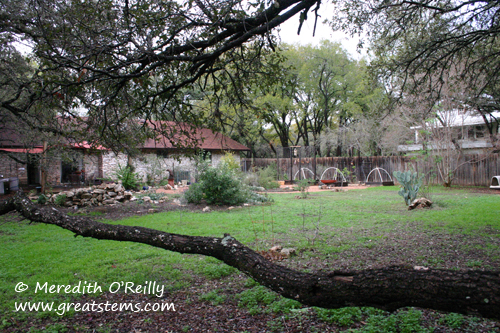 |
|
|
|
| And so overall, our garden didn't change that much from the previous year, other than than to look less robust. We protected our young native trees, first and foremost, and the only new garden bed was a berm around our backyard pond. Amazingly, those berm plants actually thrived quite well despite the sun's death rays upon them. |
|
| Because of the drought, we had to leave most of the berm unplanted, but we did transplant select plants from other areas around the yard and tucked in a few freebies that were given to us. So while the new garden bed isn't beautiful yet, it's got potential for the future. |
|
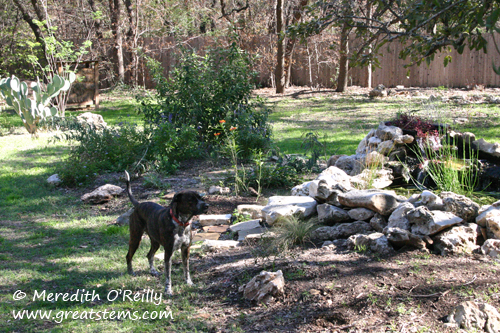 |
|
|
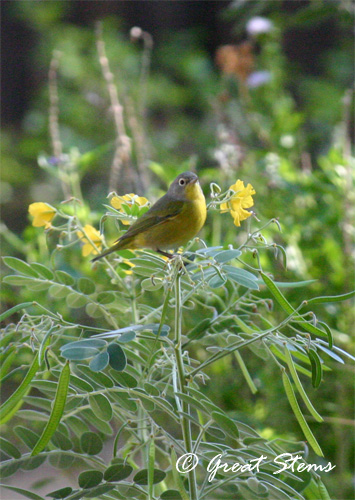 |
|
Most importantly, though, is that the wildlife greatly appreciated the plants that were there. The sennas proved to be most popular with the warblers in late summer, and the few pollinators that braved the heat spent much of their time at the Gregg's Mistflower, Texas Lantana, and other blooming plants. |
|
| A couple of young trees in the far reaches of the backyard didn't make it, but other young ones did remarkably well. In the fall, we planted a few more trees, small but with potential. This Lacey Oak, for example, replaced the Chinquapin that did not survive the drought. We also added a few other species -- Monterrey White Oak, Shin Oak, Escarpment Black Cherry, and others -- all small enough for easy watering and placed in the ground as soon as conditions were reasonably favorable. |
|
|
|
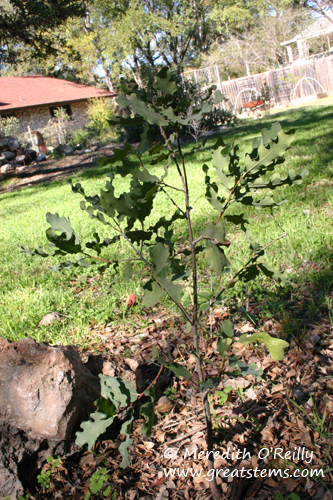 |
|
|
| The Pomegranate tree didn't bear fruit in 2011, but it grew quite large. Maybe next year will be the year for better fruit production. Alas, the citrus trees didn't survive -- in fact, most of my container plants suffered quite a bit, as they needed more water than I was willing to spare in the drought. |
|
|
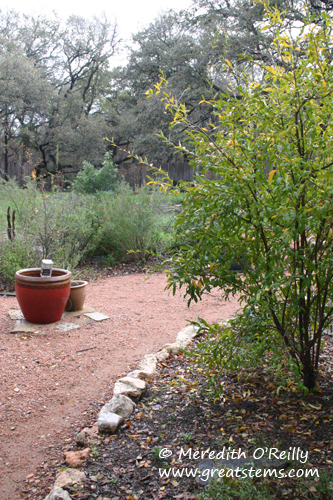 |
|
|
|
| And for the same reason, I did not work in the veggie garden in 2011, but this next year, I'm likely to try again. |
|
|
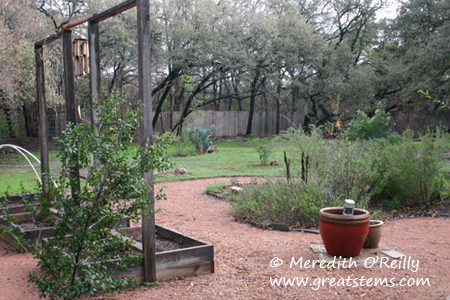 |
|
|
| The biggest improvements related more to areas closer to the house. Early in the year, we finished up the flagstone patio on the back porch. Having flagstone there instead of the old concrete slab gave transformation to our backyard like no other. Now when we step outside, we don't see a drab slab, we see something fab, and the back porch lures us outside to read or birdwatch. |
|
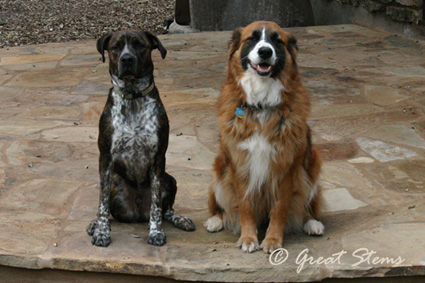 |
|
|
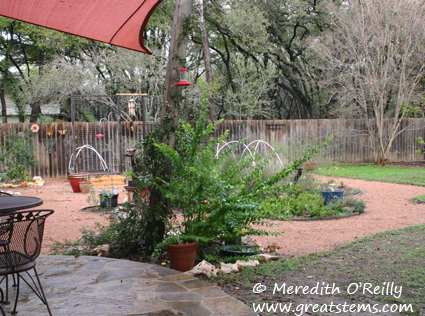 |
|
| The front of the yard had its own major transformation, with the addition of a very special gate that we adore. |
|
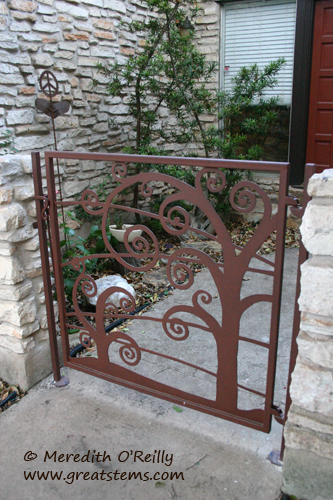 |
|
|
|
|
| The gate creates a sense of simple beauty and tranquility as you approach the front of the house, and add to it the bonus that the dogs no longer try to charge out whenever visitors accidentally leave the front door open (at least as long as said visitors still close the gate, mind you). |
|
| Another great accomplishment for 2011 was the completion of our woodland pathway in the sideyard. The modest walkway is made of cedar slices "grouted" with the cedar shavings that resulted from cutting the wood. Though I envision plants to fill in the barer garden patches once the drought gives us a break, I find such joy just looking at the pretty path. It's proven to be a wildlife attractor, too -- one of my favorite occurrences is seeing a large visiting flock of white-winged doves land on the path and progress like an army as they walk down the path looking for fallen seeds. It's really quite amusing and something I hope to capture with a camera one of these days. |
|
|
|
|
|
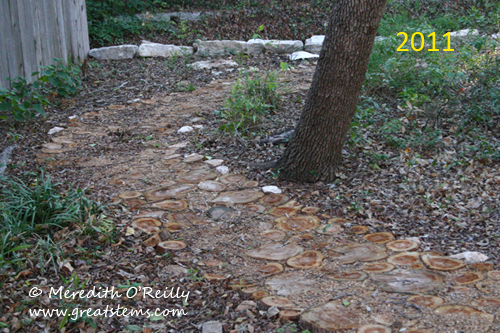 |
|
|
|
|
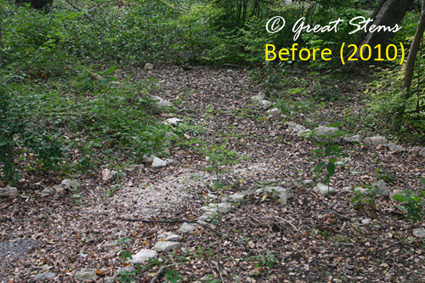 |
|
| Here's how the sideyard looked at this time last year. Such a difference! |
|
| Though we haven't yet written a full post about our third and newest pond, here is a glimpse at it. Placed near our main birdfeeder, the pond has a bubbling rock in the center to invite birds down for a drink. While I do like the pond being there, I have to say that its presence makes cleaning the windows above it more of a challenge! By the way, this pond cost us about $65 -- another inexpensive do-it-yourself project. It cost us slightly more than our other small pond, because we added a filter box around the pump to keep leaves out it. |
|
|
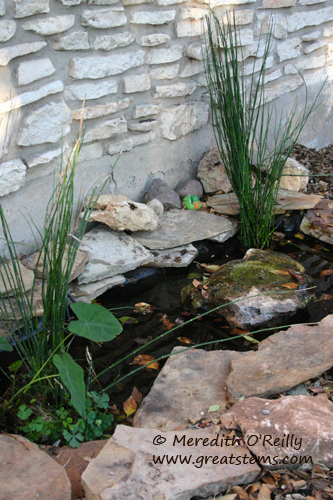 |
|
|
|
| Even though 2011 had its challenges thanks to the drought, I feel we made wonderful improvements. And the value of our young habitat was still great -- we had more bird species and higher numbers than ever before. I know part of that is due simply to the fact that drought and fire brought more birds into the city than normally would be here, but we've worked hard to make this a bird-friendly environment, and it appears that the birds agree. I only wish that the drought hadn't greatly affected the numbers of butterflies, caterpillars, bees, and other wildlife that we'd normally also see. |
|
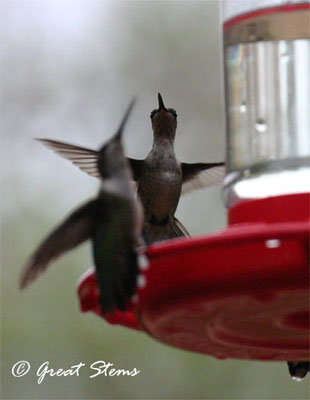 |
|
Some of the wildlife highlights of the year included our peak of 15 hummingbirds all feeding together (I imagine there were more in the trees), our first baby screech owl, and the many different visiting warblers. We also had more lizards than usual, presumably searching wherever they could for insects. And who could forget the Great Skunk Incident of 2011? |
|
|
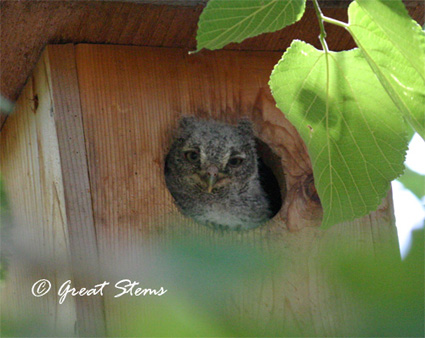 |
|
|
|
| On a personal note, I transitioned from my role as our elementary school's Green Team leader to expanding speaking engagements, taking on additional volunteer jobs, and becoming a new Habitat Steward trainer. I also enjoyed helping National Wildlife Federation reach out to Austin-area elementary schools and middle schools to build new schoolyard habitats. It's been a busy year, absolutely, but a good one (barring drought issues, mind you!). |
|
| To see the full journey that has been our garden, I encourage you to look back at the garden update pages from the previous two years. While the garden looked prettier last year, I'm still proud of all we've accomplished in such a short amount of time overall. |
|
|
|
|
|
Year One: 2008-2009 |
|
|
| Year Two: 2009-2010 |
|
|
| What's in store for the next year? Once again, we'll help our plants survive the continuing drought, and we'll keep planting to a minimum. I'm hopeful that this year we'll start our new shed, but whether we'll get it finished in 2012 is the big question (we being turtles). The most important thing is that we are still having fun, and nature is such a pleasure to provide for. |
|
|
Happy Gardening! -- Meredith |
|
|
|
|
|
|
|
|
|
|
|
|
|
|
|
|
|
|
|
|
|
|
|
|
|
|
|
|
|
|
|
|
|
|